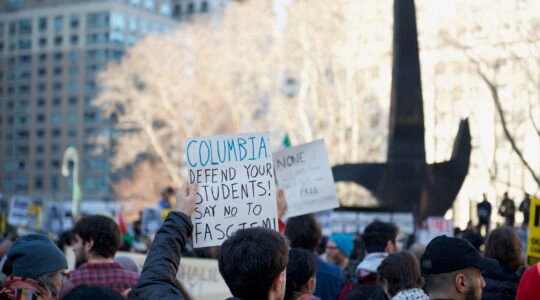CREEDMOOR, N.C. (JTA) — “Are you going to the singing thing?” my camp friend texts me. It’s 11:58 a.m., I’m working, and she’s 543 miles away. The song session begins at noon.
“Coming soon,” I respond.
I get there before she does, the music just beginning when I arrive. The energy is welcoming and joyous, and even though I’m not sure I know anyone, I start to sing along — loudly. My friend shows up by the end of the song, though I can’t see her walk in or hear her voice join mine. We’re on a Facebook livestream, and by the end of the hour, over 90 others will be watching and singing along with us.
I can’t stop smiling. People keep commenting “my heart is so full.” This is the first time in years that I’ve been a part of a group coming together just for the sake of being Jewish — and it only took an international pandemic to make it happen.
As a grad student with chronic illness living in a rural community, staying involved in Jewish life has been difficult at best. The hour drive to services doesn’t feel doable very often, and when it does, I’m often exhausted. Or I’m short on gas money. Or the dog is throwing up. Or I remember how the membership chair introduces himself every time I go, even though I joined three years ago. Something always comes up, and after a certain amount of time away, returning is embarrassing — and so somehow, I’ve become just another one of those disengaged 20-somethings, a different sort of pandemic feared by synagogues everywhere.
But in the face of COVID-19, something is happening that’s gotten me involved again: As community spaces close their doors for the sake of public health, a number of wildly diverse Jewish offerings have started appearing online. Finally, Judaism is accessible for all.
My calendar this week is more full than it could be at any physical shul I know of, even if other factors didn’t keep me home. There is Torah study, challah baking class, rabbi-led meditation, readings by Jewish authors. There are more options for Shabbat services or daily minyans — like the one being offered every weekday by MyJewishLearning — than I could attend in a year. Sure, livestreaming services have existed for a while now. But every time I tried one before, it meant watching from a camera placed on a balcony or in an aisle, the backs of people’s heads reminding me I was only an observer of someone else’s community. Now I can see the rabbi’s eyes. I can chat with everyone there. I may be welcomed by name.
It’s not that this isn’t a terrifying time. It is. But isolation has given me access to exactly what I need to get through the panic: connection. Ritual. A community that feels ancestral and enduring. Suddenly I have the adult Jewish life I once dreamed of and had nearly given up on. Quite frankly, I’m overjoyed.
What’s going to happen in the weeks to come? Four days ago, I would have said I’m socially distancing with the goal of joining my family safely for Pesach. Today I registered for a workshop on leading a virtual seder. Nobody knows how long we’ll be at this or what the world will look like when it’s through — but what I’m more interested in is what happens then. Will all these offerings disappear? Will virtual services return to the webcam-on-a-balcony model, leaving those of us stuck at home where we were before?
I’m hoping for a different story.
It’s no secret that Jewish organizations worry about youth disengagement. But based on my social feeds this week, they don’t need to be — and I don’t think it’s just because we’re in a pandemic. I believe if we had this sort of access all the time, the problem would disappear.
This Saturday, I’ll celebrate Havdalah with a group I’ve been trying to get together with for over a year. When I’m healthy and available and interested in an event some time in the future, I’ll be more likely to attend knowing the awkward first introductions are behind me. When my illness keeps me home for weeks at a time, an occasional Zoom Torah study would help keep me from feeling too ashamed to return. If I’m studying too late, I’d feel fine clicking into an ongoing service that I’d never attend if I had to walk in late and interrupt. Being able to attend from bed? It makes a huge difference.
The Jewish community should be taking notes right now: Accessibility helps everyone, and virtual experiences can be just as creative and engaging as in-person ones. People want to be involved. You just have to make it easy for them.
Laughing emojis fill the screen of the song session. Someone’s just written in the comments, “if you don’t know the lyrics to this, it’s nai nai nai nai nai nai.” I’m starting to recognize people’s names, even though I’ve never seen most before today.
“So where’s everybody from?” scrolls by. People check in from California, Missouri, Tel Aviv.
And then I see someone say: “Why did we wait until a virus to do this?”
There’s not a good answer. We didn’t have to. We just did.
At a time of uncertainty, these online gatherings give me hope — for the current moment, yes, but also for my future Jewish life and the future of the Jewish community as a whole. I wish I’d had this before. I’m glad I have it now. Let’s not wait to do it again, please. Not even when the coronavirus pandemic is done.
JTA has documented Jewish history in real-time for over a century. Keep our journalism strong by joining us in supporting independent, award-winning reporting.







